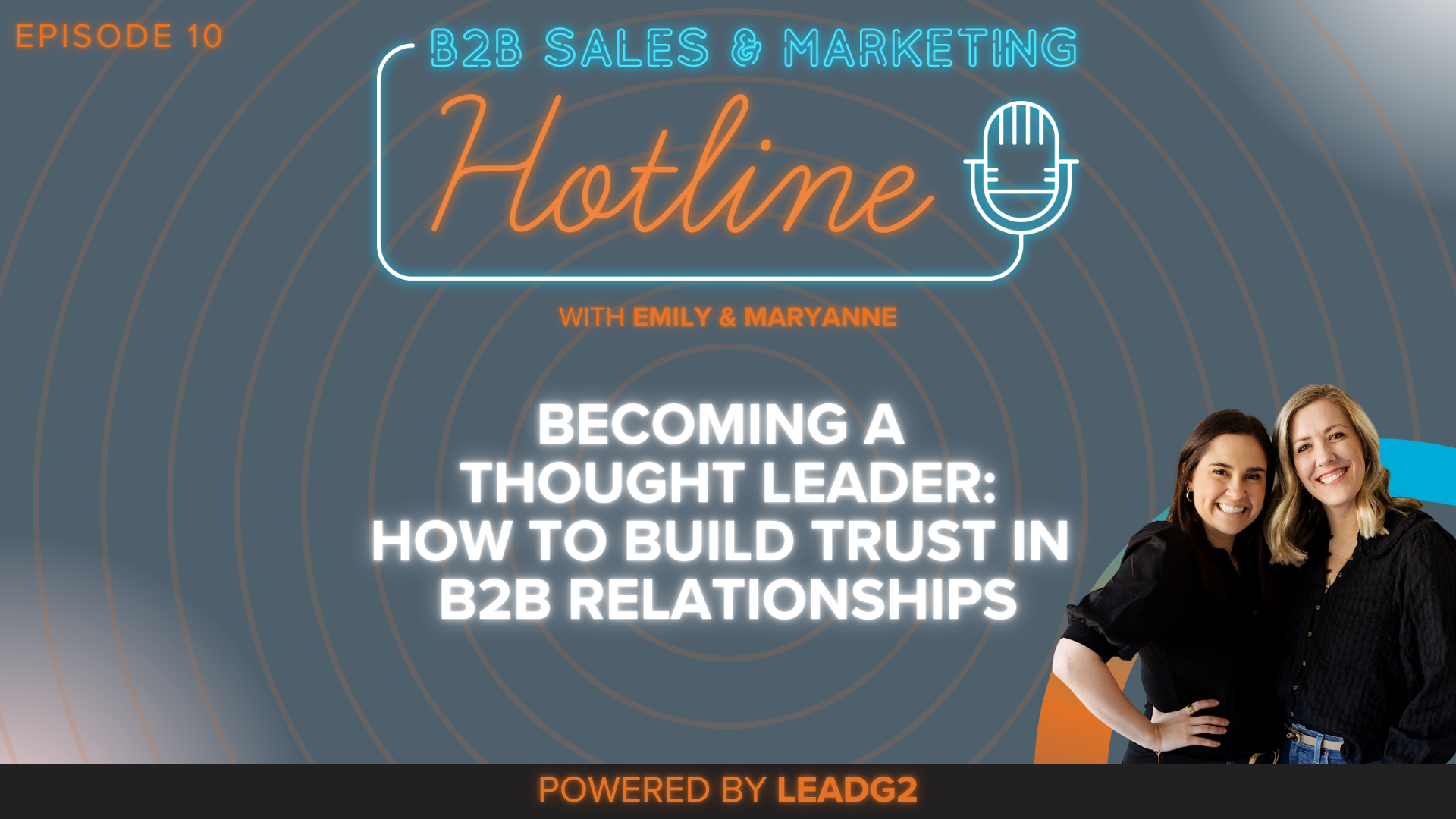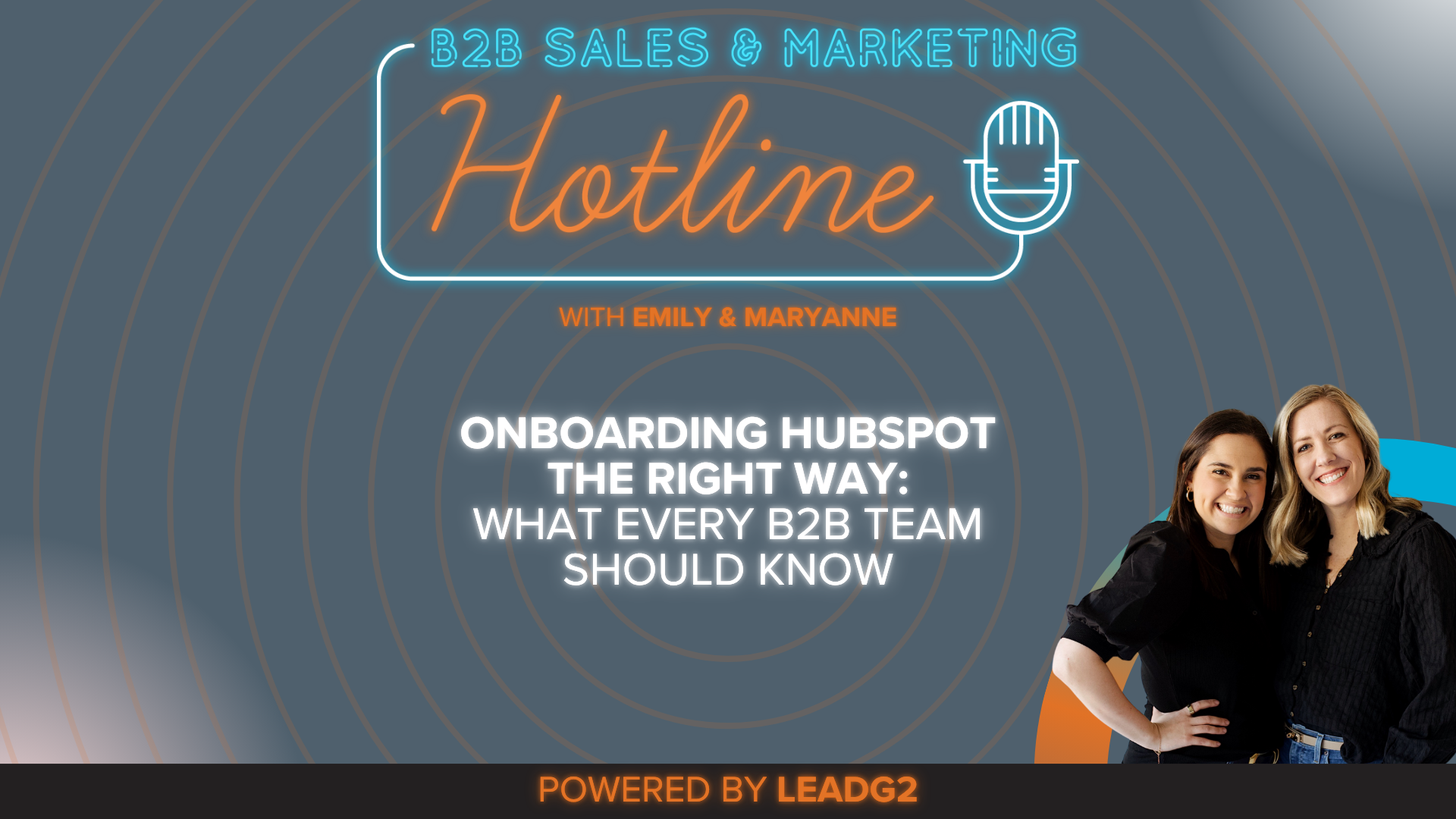9 min read
Cracking the Code of B2B Thought Leadership with Bill Sherman
 Brent Tripp
:
August 2, 2023
Brent Tripp
:
August 2, 2023
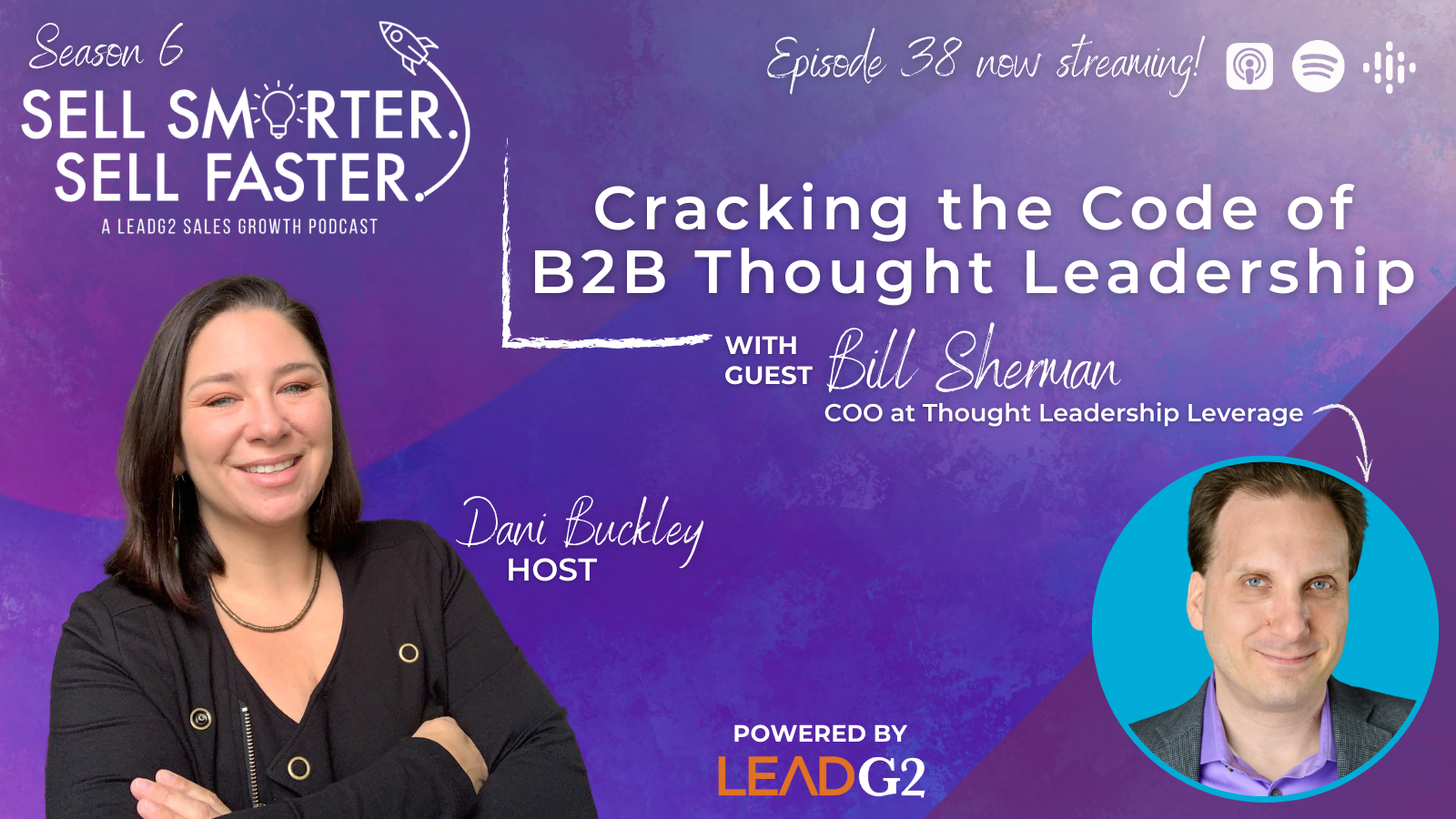
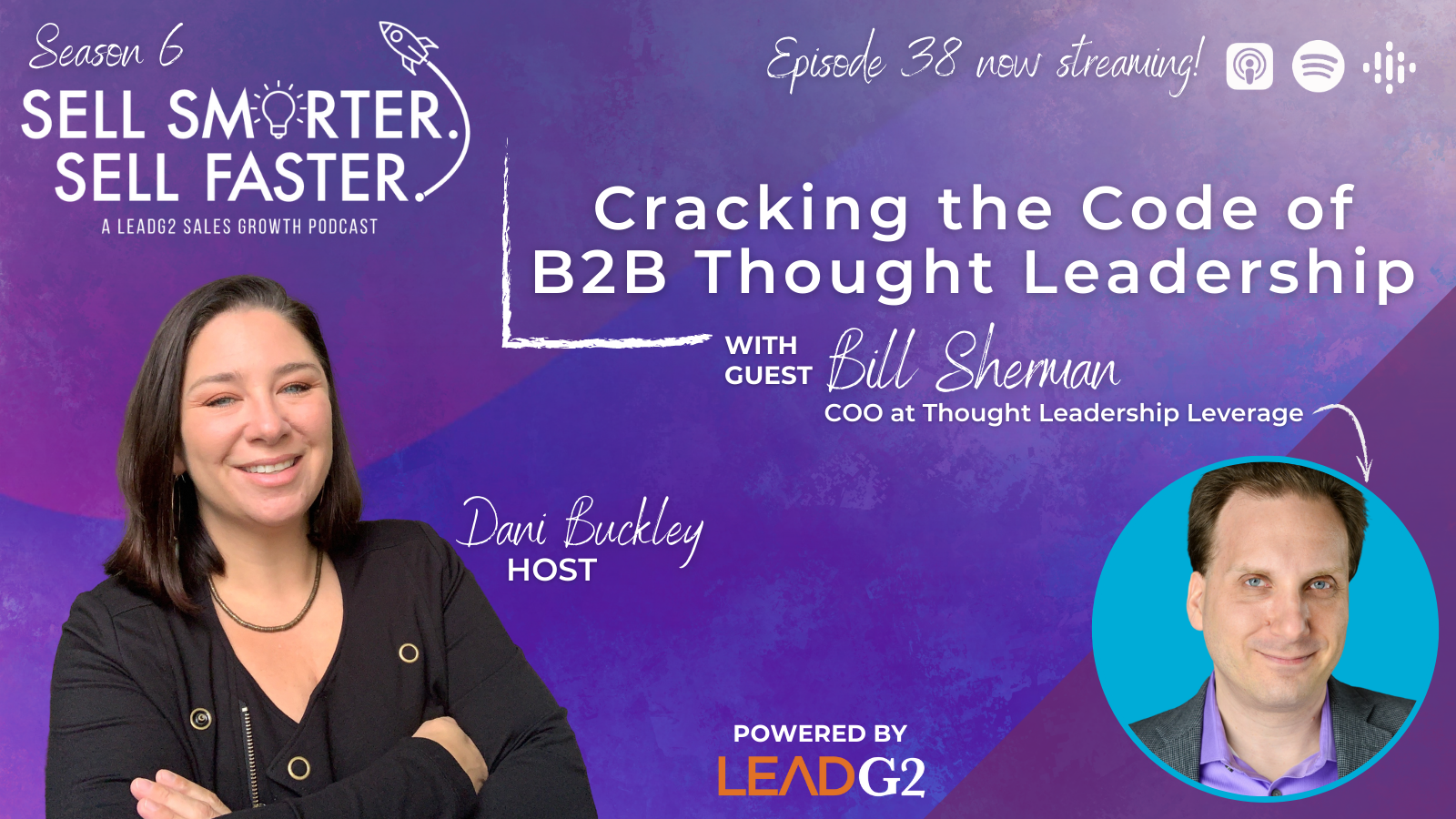
In this episode, we're breaking down how thought leadership can play an important role in maximizing your B2B sales efforts.
Here we tackle questions like what exactly is thought leadership and why does it matter in B2B sales? Who is it for? How can sellers incorporate thought leadership into their own strategy, as well as into different parts of the sales process? How do you go about measuring the ROI of thought leadership?
Joining Dani Buckley to answer those questions and more, is Bill Sherman, COO and Thought Leadership Practice Lead at Thought Leadership Leverage. Bill makes some great points, such as:
-
How true thought leadership begins with a provocative idea that starts a conversation
-
What initial steps you can take to get started right away
-
And, finally, how your own thought leadership can be one of the few sustainable advantages that you can have as a seller
How Do You Ensure Your Company is Known for Having the Smartest People?
“So, I feel like, at this point, it's fair to say that most of our listeners know by now that thought leadership is important,” Dani says. “They've heard about it; they're maybe doing it; they understand it to some extent.
“But I often hear folks that are saying maybe it's not quite right for them, or that it isn't totally a fit for their business, or they don't really see why they should devote time to it. Can you share a little about the why thought leadership matters and who it's right for?”
“So, let me frame this,” Bill says. “If thought leadership is taking ideas to scale, to produce impact, right, then it's hard to say it's not right for anyone who has an idea, whether that's an individual or an organization.
"What we've seen over the last, say, four years, maybe five, is that the organizations that are using thought leadership, especially in the sales process, have evolved.
“It used to be that it was professional services primarily that would focus on thought leadership. because you're selling consulting services, you're selling, basically, smart people. And how do you demonstrate that they're smart? Thought leadership.
“But more and more organizations are recognizing that we need to showcase the really smart people that we have and the points of view that we have within the organization and get that out to our buyers.
“And so, you've seen over the last four, five years Fortune 500 companies setting up a formal function for thought leadership, not that they have to be the smartest people in the room, but making sure that those ideas get out through sales channels, through marketing.
“I've seen mid-cap organizations saying this is going to be our differentiator for how we go to market, because we can't be as big as the big organizations, but we can show we think more actually.
“Then I've seen startups as well, where they say, ‘hey, we've got either VC funds, and we're trying to grow and accelerate and we want our voices heard,’ or some of those startups have an eye on an IPO. They're saying, ‘we want to make sure we get the best valuation when we go public.’
“The best way to do that is make sure that we're known for being forward-thinking, smart.”
Thought Leadership Starts with that Provocative Idea that Starts a Conversation
“I love that you keep using the word ideas,” Dani says. “I think some folks think thought leadership is just, ‘I share articles on social media.’ Which is nice to do and invaluable, but I think there's a line of what actually makes someone a thought leader.
“It is more about being proactive in sharing your ideas, your opinions, things like that. It sounds like you agree.
“I'd love to hear your thoughts on how you would further define it, but also if you could give a couple of examples of actions that a business leader or a salesperson can take that is thought leadership.”
“Sure,” Bill says. “Let's distinguish between content marketing and thought leadership. That's probably the easiest place to start.
“Content marketing typically leads immediately towards a product conversation. You may be informing, but it's really tied to product marketing or solutions-based marketing.
“Thought leadership is getting your target audience to one, be aware of who you are if you want to build your brand and visibility. And two, get them to raise their eyes from the next step in front of their feet and to, instead, think about six, twelve, eighteen months, maybe three to five years ahead, depending on your field and your organization what's possible. ‘What do I need to prepare for?”
“An idea, at its core, isn't a business book, it isn't a white paper, it isn't even an article. An idea is really simple.
“An idea, at its core, is a sentence, maybe two, that is a little bit provocative. It gets someone to stop, either through their feed on LinkedIn or in a conversation, and go, ‘I haven't heard that before. I'm not even sure I agree with you. But you know what? Tell me more. I want to understand a little bit more.’
“And thought leadership begins with that provocative idea that opens a conversation. Then you can start making the case. You can provide stories, data, examples, case studies, references, all of those things that start to prove your point of view.
“But it begins with that little nudge, ‘have you thought about it this way?’”
“Love it, love it,” Dani says. “What a great way to define it.
“And it's risky, right? It's scary. That's why not everybody is a thought leader, because people are scared to, sometimes, make a statement. And maybe you might change your mind, maybe it might open up a discussion, and I think that's part of it, too, is being open minded to the conversation that can happen around these statements or opinions.”
“And to your point,” Bill says. “You can do a couple of different things.”
“You can advance an existing conversation. So, if people are talking about a subject in your field, what's your point of view? What is something that's not being talked about but is related? That's one way to do it.
“Or you can open a topic that needs to be talked about but isn't on people's radar in your field.
“Those are two different ways of becoming active in thought leadership.
“The easier one is joining an existing conversation and pitching a penny or two. The harder one is when you say, ‘no, I disagree. Here's something that we need to be talking about, that's not being talked about, and I'm going to either write a post on LinkedIn, do a short form video, write a white paper,’ and they range from small, short form ways of creating thought leadership all the way to writing a book. But I think of the book or the white paper as sort of the capstone rather than your first attempt into a conversation.”
Buyers Used to Be Less Informed Than You. Now, That Has Flipped.
“Okay,” Dani says. “Let's focus on actual B2B sales and sales in general. How do you think sellers should be incorporating thought leadership into their own strategy and different parts of the sales process?”
“Let's acknowledge something that's happened within the sales ecosystem, not only in B2C but B2B,” Bill says. “Your buyer used to be less informed than you on the topic. Now that has flipped.
“You don't know when they're in a buying cycle, You don't know what their buying criteria are, and they may have done more due diligence and research before they even reach out to you.
“There's an asymmetry of knowledge, typically in B2B, now when they're reaching out. Often, they're reaching out with very specific questions and they're close to the end of the buying cycle rather than the beginning of the journey.
“So, if you're not joining the conversation where they are early, you're not on their radar. They're not going to reach out to you. You're essentially invisible, right?
“Part of it is being proactive in conversation and being able to be visible to your target audiences. The second thing is, if you've got an existing client base and you're managing current accounts, for example, you want to be able to have something interesting to share to get your buyers thinking about the future. That means not only what you're selling today and what's your target, but you want to be planting seeds for the future.
“And I think of it this way, you can be Bart Simpson in the back of the car going, ‘Are we there yet? Are we there yet? Are you going to buy? Are you going to buy?’
“Or you can give them something interesting to think about. With the latter? They'll take your call again and again.”
Dani says, “The language I use a lot is, ‘Stop just checking in. Have a reason.’ What you're saying is to provide value at every touch point. Don't just be circling back, wondering if they’re ‘going to buy yet.’”
“And if you're a seller and your organization has super smart people, maybe in ops or product or research, what can you pull from that group?” Bill says. “What can you share around what's coming to help your buyers be more prepared and make you a trusted advisor so that, when they have a question, they pick up the phone and call you or they send you an email and say, ‘hey, what do you think?’
“Those are the easiest sales.”
When it Comes to ROI from Thought Leadership? Start with a Crawl, Walk, Run Approach
“Let’s talk about ROI,” Dani says. “How we go about measuring ROI is tricky in all kinds of tactics that we use, but it's particularly tricky with thought leadership. So, I'm curious how do you go about measuring it and what might you recommend? How can we know it's making an impact?”
“You probably have thought leadership going on in your organization already. Somebody is doing thought leadership on social, or speaking at events or writing a paper, etc.
“What happens is it's sort of ad hoc and impromptu and there's no tracking for it. And so, if you're not tracking what's being done, it's really hard to attribute anything from either pre-sales or sales evangelism or even attribution towards the sale, right?
"I recommend starting with a crawl, walk, run approach:
-
Crawl: “The first thing is start tracking it, even if it's just simply in an Excel spreadsheet. What's being done. Who are you talking to? Where did you engage? Either on a one-to-one and a sales conversation, maybe with a senior level buyer, or maybe you spoke at a conference or you made a presentation. Great, start tracking those things.
-
Walk: “The next step, then, is tying it to actually moving through a sales pipeline. And thought leadership often has a longer and indirect sales cycle because you're educating your buyers. But what you'll start hearing is, ‘hey, i've been following you or I've been listening to your podcast for a long while.’
“Now's the right time for me to reach out, because they're ready to buy, and you get what I describe as the old radio approach of ‘long-time listener, first-time caller.’ You will get those, you start tracking those, and you're like, ‘Wow, these were people who were tuned in to us, but we didn't even know they were listening to us, right?’
-
Run: “And then, finally, the most sophisticated way is if you're using something to manage the sales cycle of moving through the pipeline, you set up a formal process of what gets shared when, and then you can start seeing, ‘did they open it, did they look at it, did they engage with it?’
“And then you can start making some informed choices around attribution and percentage attribution and if a sales lead hasn't become a qualified opportunity, how do you nudge it? Or if an opportunity gets stuck, how do you move it forward? Sometimes through thought leadership.
“Great,” Dani says. “I love it. Those are such good examples.”
Actionable Tips for Anyone Looking to Boost Their Thought Leadership Efforts
“Hopefully, some folks listening are starting to think, ‘I need to take some action,’” Dani says. “’What can I do?’
“What would be some initial first steps that you would recommend?”
“I'll give a few starters,” Bill says. “But I'm also going to underscore something that I think is absolutely essential.
“Number one, you need to have discipline to this. You can't say, ‘Hey, I'll do thought leadership for a month, or I'll make one post or two posts.’ This has got to be something you're willing to commit to for a period of time, six months, a year, on a consistent cadence.
“The second thing that I would say, in terms of easy things, is it's okay to start small. Start on LinkedIn, and make a post once or twice a week. Or even go simpler. Start commenting on people's posts and engaging with them to advance an existing conversation. You can then take those comments and turn them into posts yourself.
“Additionally, know what medium you're comfortable with. Some people are more comfortable with recording videos than they are writing. If writing is not your jam, pull out your phone, cue up Zoom or Teams, record a 60-90-second video, post it, and engage with the comments.
“Now, let's go to the intermediate. If you really want ROI from a sales perspective, you've got to have a strategy. Who are you trying to reach with this? What call to action is it? And it isn't always a buy-from-me call to action. It may be a ‘call to education’ or a ‘call to a further conversation’ rather than a straight out, ‘here's the call to action to buy.’
“And it's not about you just being comfortable with creating the content and the modality. We're on a podcast now. We're doing a video. We could be writing a piece, but it also depends on where your audience is.
“Are they comfortable watching? Do they prefer reading? You've got to meet them where they are, which, sometimes means, you move out of your comfort zone.
“But the easiest way that I've found is to give yourself a 30-day challenge. I've challenged people, ‘put a topic out for conversation each day.’ It doesn't have to be big; it doesn't have to be a new idea every day. It's okay to repeat. Most businesses really only need one to three big ideas at a time and they can run with them for three to five years.
“So, as you start making it relevant to your target audience, how it fits their needs, their opportunities, their pain points, you find you have plenty to take and post.
“The other thing I do is keep a small set of Post-it Pads by my desk. If I have a turn of phrase that I really like, or an insight when I'm explaining something or answering a question to a live customer, I will write it down. Guess what? That becomes part of my posts on social media.
“Also, we all have this, where you answer a question in real-time, but your answer is like a C-plus. And then you think about it, and an hour later, you've got the A-level answer.
You're like, ‘Man, I wish I said that.’
“Instead, what I do, is I'll write that A-level answer on a Friday and say, ‘Hey, I was thinking about this. Here's the reply I sent to you. And oh, by the way, I put it on social media as well,’ because if one buyer asks that question, more probably have as well.”
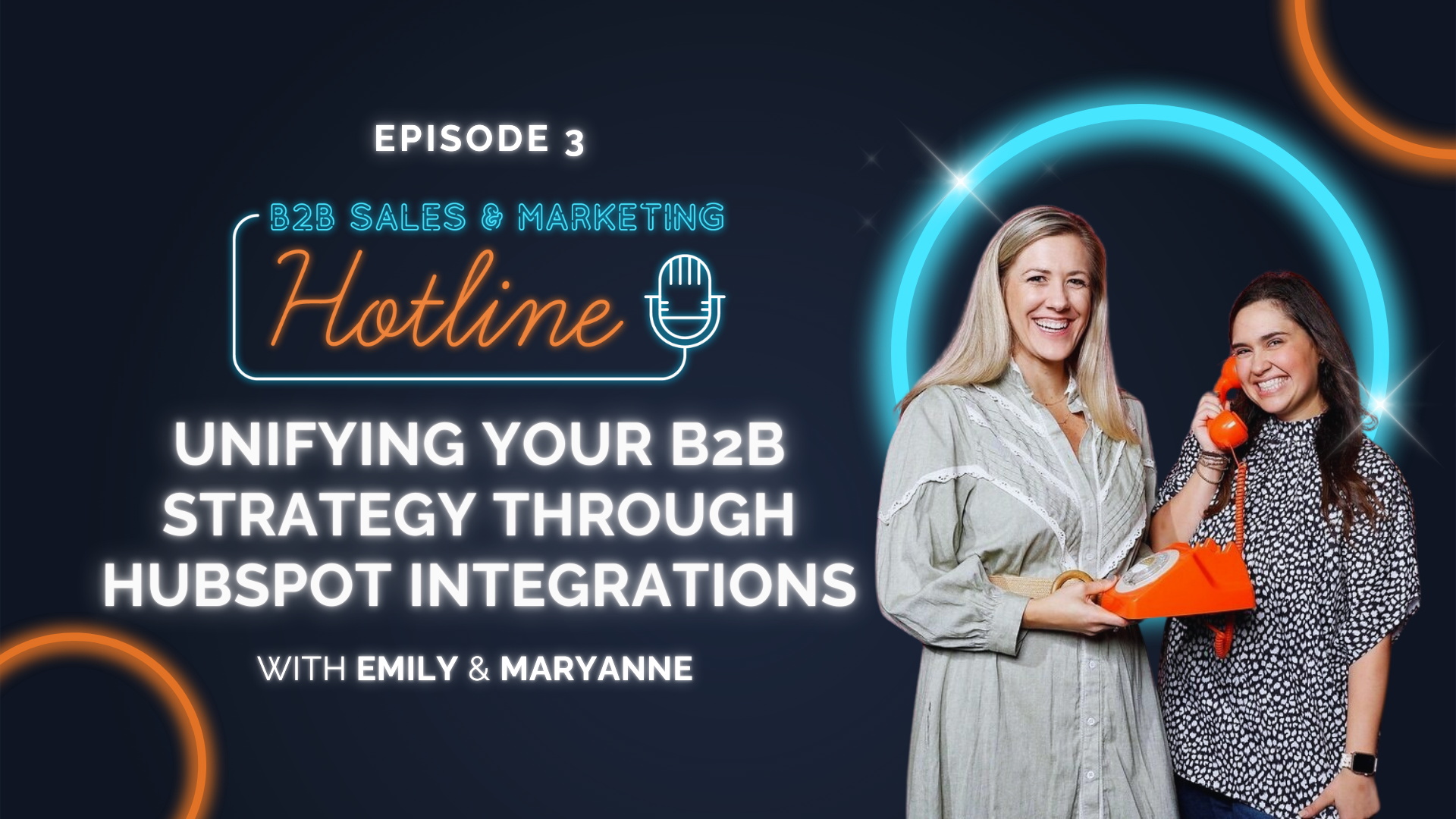
Unifying Your B2B Strategy Through HubSpot Integrations
In this episode of The B2B Sales & Marketing Hotline, we're exploring the world of HubSpot integrations to help you craft a unified B2B strategy....
.png?width=2250&height=647&name=LeadG2-logo_(2).png)


